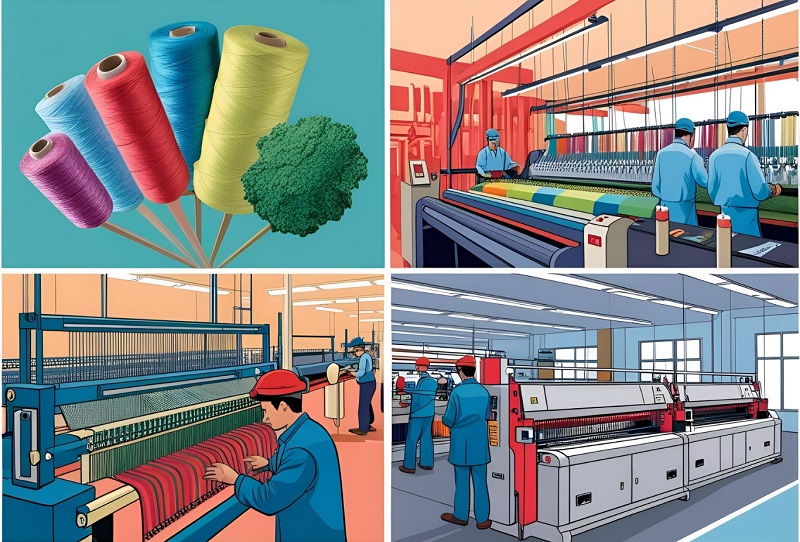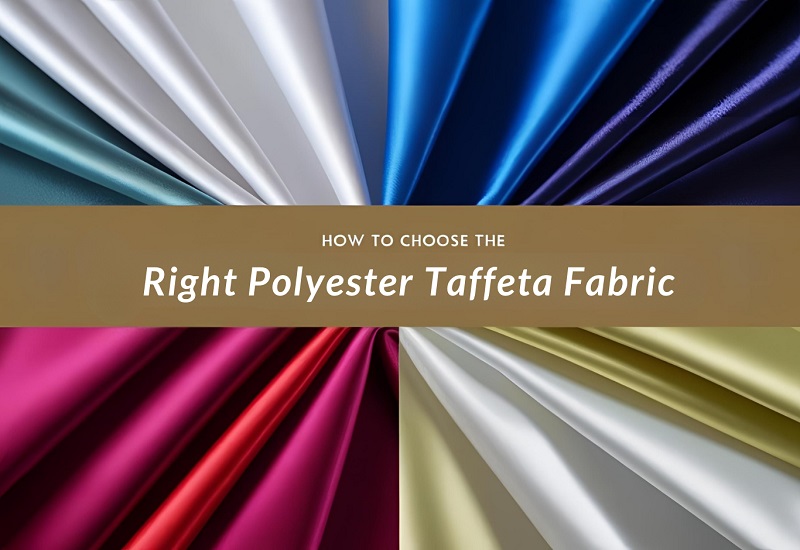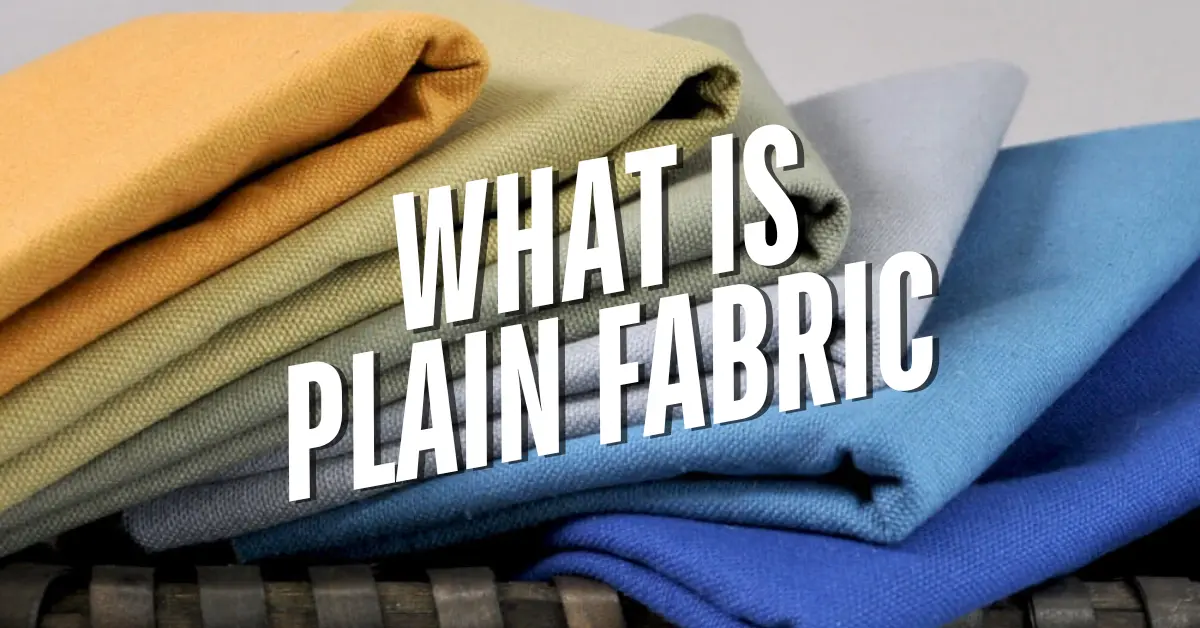What Is Polyester Taffeta Fabric?
What is polyester taffeta fabric? Polyester taffeta fabric is a synthetic textile crafted from polyester fibers woven in a plain weave pattern. This construction results in a smooth, glossy surface with a crisp texture, making it a popular choice for various applications.
Characteristics of Polyester Taffeta Fabric
- Durability: Polyester taffeta is known for its strength and resistance to tearing, ensuring longevity in garments and décor items.
- Wrinkle Resistance: The fabric maintains a neat appearance with minimal wrinkling, reducing the need for frequent ironing.
- Lightweight: Its low-density composition makes it comfortable to wear and easy to handle in various sewing projects.
- Sheen: The inherent sheen of polyester fibers gives the fabric an elegant and sophisticated look.
Common Uses of Polyester Taffeta Fabric
- Formal Wear: Its crisp texture and lustrous appearance make it ideal for evening gowns, prom dresses, and wedding attire.
- Linings: Often used as a lining material in jackets, coats, and bags, providing a smooth finish and added durability.
- Home Décor: Utilized in creating luxurious curtains, draperies, and tablecloths, enhancing the aesthetic appeal of interiors.
Care and Maintenance of Polyester Taffeta Fabric

Proper care extends the lifespan and preserves the appearance of polyester taffeta fabric.
Washing Instructions
- Machine Washing: Use a gentle cycle with cold water and mild detergent to prevent damage.
- Hand Washing: Immerse the fabric in cold water with a small amount of mild detergent, gently agitate, and rinse thoroughly.
Drying Guidelines
- Air Drying: Lay the fabric flat on a clean, dry towel away from direct sunlight to maintain its shape and prevent shrinkage.
- Avoid High Heat: Refrain from using high-temperature settings in dryers, as polyester fibers can shrink when exposed to excessive heat.
Ironing Tips
- Low Heat Setting: If ironing is necessary, use a low-temperature setting to prevent melting or damaging the fibers.
- Protective Layer: Place a pressing cloth between the iron and the fabric to safeguard the material.
Environmental Considerations
While polyester taffeta offers numerous benefits, it’s essential to consider its environmental impact.
- Synthetic Origin: Derived from petroleum-based products, polyester is not biodegradable, contributing to environmental concerns.
- Recycling: Efforts are underway to improve recycling processes for polyester fabrics, aiming to reduce waste and promote sustainability.
Understanding what is polyester taffeta fabric, its characteristics, uses, and proper care techniques ensures that this versatile material remains a valuable choice in fashion and home décor.
Manufacturing Process of Polyester Taffeta Fabric

The production of polyester taffeta fabric involves multiple stages to achieve its distinctive smooth and crisp texture.
Fiber Production
- Polymerization: Polyester taffeta is made from polyester fibers derived from petroleum-based raw materials through a polymerization process.
- Extrusion and Spinning: The polymer is melted and extruded through spinnerets to form continuous polyester filaments.
Weaving Process
- Plain Weave Structure: Polyester taffeta is woven using a plain weave, where the warp and weft threads cross over each other in a simple pattern. This tight weave gives the fabric its signature crispness.
- Dyeing Techniques: The fabric can be dyed using piece-dyeing (for softer textures, commonly used in linings) or yarn-dyeing (for more structured applications like evening dresses).
Finishing Treatments
- Calendering: The fabric is passed through heated rollers to enhance its sheen and smoothness.
- Water-Repellent Coatings: Some polyester taffeta fabrics are treated with a water-resistant finish, making them suitable for outdoor gear and umbrellas.
Advantages and Disadvantages of Polyester Taffeta Fabric
Benefits of Polyester Taffeta
✔ Affordability – More cost-effective than silk taffeta while offering a similar luxurious look.
✔ Low Maintenance – Wrinkle-resistant, easy to clean, and does not require special care.
✔ Durability – Strong synthetic fibers make it resistant to tearing and wear.
✔ Moisture Resistance – Unlike natural fabrics, polyester taffeta does not absorb moisture easily, reducing the risk of mildew.
Limitations of Polyester Taffeta
✘ Heat Sensitivity – High temperatures can melt or shrink polyester fibers.
✘ Breathability Issues – The dense weave makes it less breathable than cotton or silk, which can be uncomfortable in warm climates.
✘ Environmental Impact – Polyester is not biodegradable, and improper disposal can contribute to pollution.
Differences Between Polyester Taffeta and Silk Taffeta
- Material Composition: Silk taffeta is made from natural silk fibers, while polyester taffeta is synthetic.
- Texture and Feel: Silk taffeta has a softer, more natural feel, whereas polyester taffeta is slightly stiffer.
- Durability: Polyester taffeta is more resistant to wear and tear compared to silk, which is more delicate.
- Cost: Polyester taffeta is significantly more affordable than silk taffeta, making it a practical alternative for budget-conscious buyers.
How to Choose the Right Polyester Taffeta Fabric

Consider the GSM (Grams per Square Meter)
- Lighter weights (40–70 GSM) are ideal for linings and lightweight garments.
- Medium weights (80–120 GSM) work well for fashion and upholstery.
- Heavier weights (130+ GSM) are preferred for structured garments and outdoor applications.
Look for Coatings or Finishes
- Water-resistant coatings make the fabric more suitable for raincoats and windbreakers.
- Fire-retardant finishes are available for specialized industrial applications.
Check the Fabric’s Use Case
- For formal wear, opt for a stiffer, yarn-dyed taffeta.
- For lining materials, choose a softer, piece-dyed polyester taffeta.
Conclusion
Polyester taffeta fabric is a versatile and durable material with applications in fashion, home décor, and industrial products. Its affordability, smooth texture, and easy maintenance make it a popular choice for various uses. However, due to its synthetic nature, it requires proper care to maintain its quality over time.
By understanding what is polyester taffeta fabric and its properties, consumers can make informed decisions about its suitability for different applications. Whether used for formal wear, upholstery, or outdoor gear, this fabric remains a practical and stylish choice.

Manager – Fabric Technical and Sourcing/Product Development/ Sustainable Material Management.
I am a B.Sc .-educated Manager of Fabric Sourcing and Technology with extensive experience in the apparel and fashion industry. Passionate about trend analysis, fabric sourcing, and sustainable textile solutions, I thrive in fast-paced environments that demand innovation, adaptability, and leadership.
As a servant leader, I am committed to honesty, transparency, and continuous process improvement. My expertise spans fabric development, product quality management, and supply chain optimization, ensuring exceptional performance across all facets of sourcing and production.
Core Skills & Expertise
✔ Fabric Sourcing & Development – Specialized in regular and sustainable textiles (BCI, Organic, Recycled).✔ Trend Analysis – In-depth understanding of global fashion and fabric trends.✔ Product Development – Expertise in material innovation and process optimization.✔ Quality Management – Strong focus on process control, ensuring high-quality production.✔ Leadership & Problem-Solving – Solution-oriented approach to team management and decision-making.
Technical Proficiency
🖥 Software & Tools:▪ Microsoft Outlook, Excel, Word▪ PLM (Product Lifecycle Management)
🌱 Sustainable & Ethical Practices:▪ Better Cotton Initiative (BCI)▪ Organic & Recycled Fabric Management
Key Strengths
✅ Solution-Focused Leadership – Driving innovation and efficiency in fabric sourcing.✅ Quick Decision-Maker – Adapting to market shifts and production challenges.✅ Team Player with a Positive Attitude – Ensuring collaboration and productivity.✅ Strong Time Management – Meeting deadlines while maintaining quality.
Professional Achievements
🏆 Li & Fung GEM Award – Recognized for fabric sourcing and supply chain management excellence.🏆 Group CEO GEM Award – Honored for outstanding leadership and process innovation.

